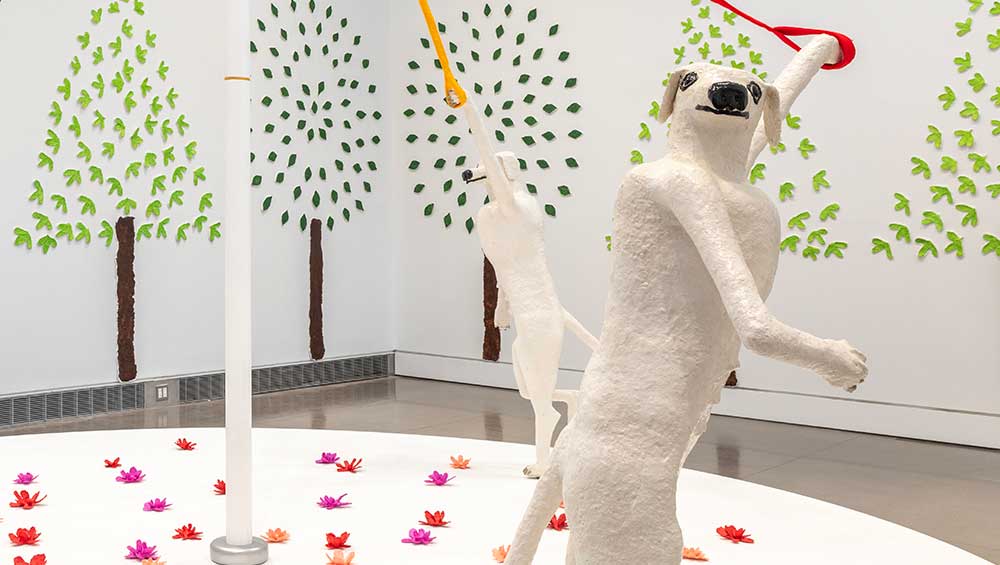
Emilie L. Gossiaux: Other-Worlding, installation view, Queens Museum, New York, 6 December 2023 – 7 April 2024. Photo: Hai Zhang, courtesy Queens Museum.
Queens Museum, New York
6 December 2023 – 7 April 2024
by ELIZABETH BUHE
As its title, Other-Worlding, suggests, Emilie L Gossiaux’s single-gallery exhibition at the Queens Museum, following a year-long residency there, offers the experience of a world different from our usual workaday lives and our acceptance, or at least tolerance, of the hierarchies its infrastructure, social codes and gendered conventions impose on us. Green-painted papier-mache leaves constellate on three gallery walls in geometric configurations to form an airy horizon of trees, and a set of three pen and crayon drawings depict Gossiaux’s guide dog, London, drawn dancing around a white pole in a flower-strewn field.
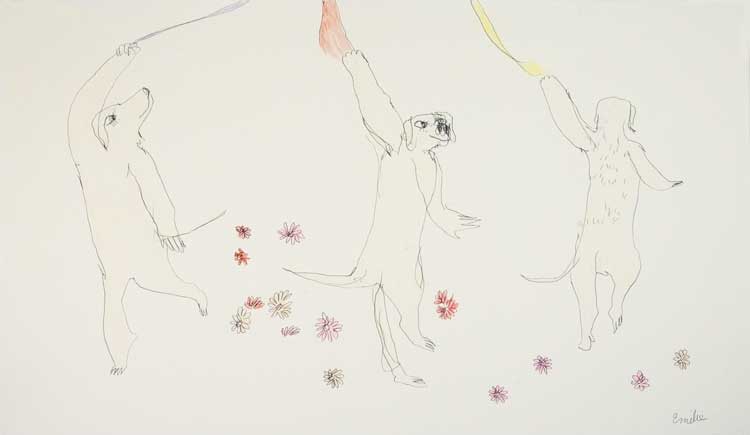
Emilie L. Gossiaux. Londons Dancing with Flowers, 2023. Ballpoint pen and crayon on paper, 63.5 x 88.9 cm (23 x 35 in). Courtesy the artist.
The drawings seem quickly rendered and therefore like sketches for the show’s main event: a centrally placed, ceiling-high installation of three Londons prancing around a maypole atop an elevated circular plinth. Each dog holds a leash – yellow, purple, red – in place of the traditional dance’s streamers or garlands. Throughout, wilfully bumpy facture, a palette of primary colours, and Gossiaux’s cast of canines put me in mind of storybook beginnings, of the “once upon a times” that presage the elaborate imaginings of different ways of living together, and that likewise attend the maypole dance’s inauguration of the new fertile season. In other words, Gossiaux’s knowing use of storytelling’s visual formal language acknowledges that stories produce, shape and sustain our knowledge about the world, and therefore that they also might contain the power to shift the patterning of that knowledge.
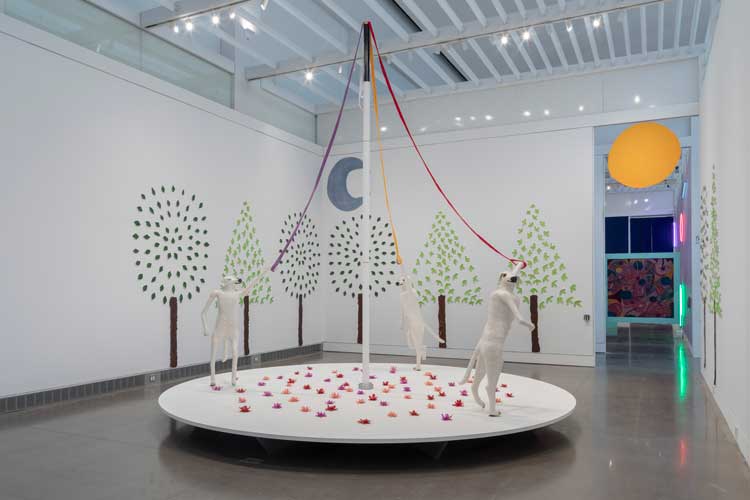
Emilie L. Gossiaux: Other-Worlding, installation view, Queens Museum, New York, 6 December 2023 – 7 April 2024. Photo: Hai Zhang, courtesy Queens Museum.
The fact that no people, just dogs and flora, are pictured here stages but one of Gossiaux’s conceptual disruptions between categories such as human/animal, male/female, disabled/able-bodied and vision/touch. The artist doesn’t invert the power dynamics that govern these pairs so much as reconfigure them as adjacencies. Hence Gossiaux’s fabric sun and moon are present simultaneously – as they often are in nature – on a single gallery wall rather than following the exclusionary alteration of one or the other that we often imagine. This is the horizontal logic of touch, contact and collaboration rather than the vertical, patriarchal, capitalist logic of hierarchy.
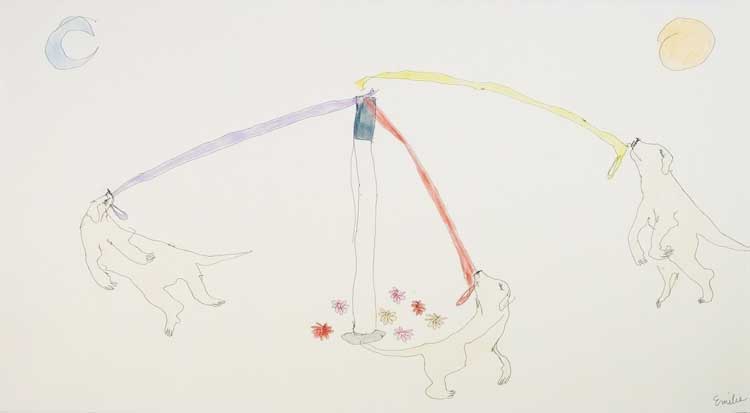
Emilie L. Gossiaux. Dancing, Again, 2023. Ballpoint pen and crayon on paper, 63.5 x 88.9 cm (23 x 35 in). Courtesy the artist.
This accords with the feminist scholar Donna Haraway’s proposals for making-with, becoming-with, and interspecies bodily cohabitation in texts such as When Species Meet (2008) and The Companion Species Manifesto (2003). Indeed, it is Haraway from whom Gossiaux borrows the other-worlding of her title, by which Haraway means the reconfiguration of human-animal entanglements as a “dance of relating” premised on response and respect. Turn back to the three sculptures of London: they are happy (one clearly smiles), each holds the leash in her hand willingly, rather than tethered at her neck, and they stand upright on two feet, adopting a human posture. Their bodily envelopes are not furry at all, but uneven surfaces of papier-mache in white, made shiny with a varnish. I felt a strong desire to touch them, which is not permitted in the gallery, though Gossiaux will lead several touch tours during the exhibition’s run. Among the work’s strengths, then, is the clarity of this message about interspecies respect, which Gossiaux elicits through multiple thematic registers and which resonates at varying levels of complexity, from the simplicity of being kind to others to theorisations of interbeing fusion.
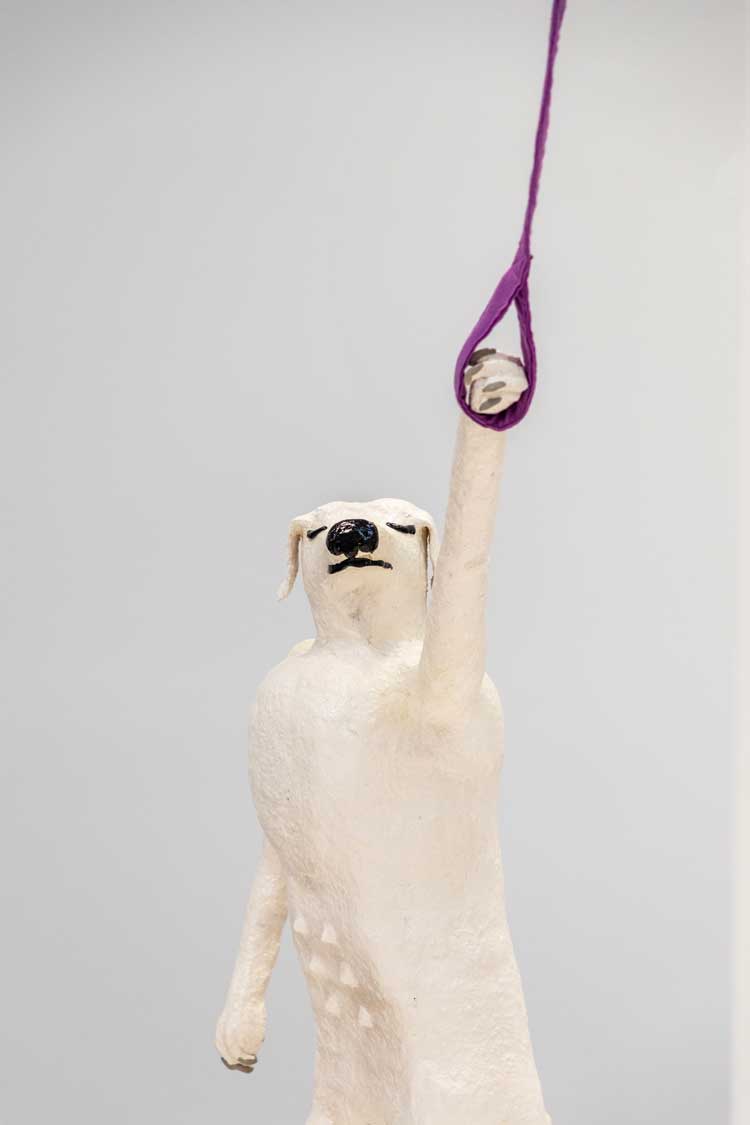
Emilie L. Gossiaux: Other-Worlding, installation view, Queens Museum, New York, 6 December 2023 – 7 April 2024. Photo: Hai Zhang, courtesy Queens Museum.
At the same time that Gossiaux’s work surfaces structural inequities that transcend the particulars of any one life, it is also deeply rooted in her own experience of blindness and use of non-visual sensory modalities. She is forthright about her embodied experience of impairment: for instance, the central maypole of White Cane Maypole Dance (2023) is not simply a pole, but the white cane used by people who are visually impaired. Gossiaux lost her vision in 2010 while a student at Cooper Union in Manhattan after an accident with a semi-truck. She has since learned to draw through touch, labelled her colours with braille, and found inspiration in dreams and memories. Above all, the show reads as a love letter to London, with whom the artist has described dancing at home to music, and whose contours and movements the artist knows primarily by touch. Only through their interdependency is each granted autonomy, which Gossiaux shows us is not a contradiction. Thus, by addressing disability directly, the work brilliantly insists on undoing separations between self and other. Reflecting this approximation between the artist and her dog, each upright sculpture matches Gossiaux’s five-foot height.
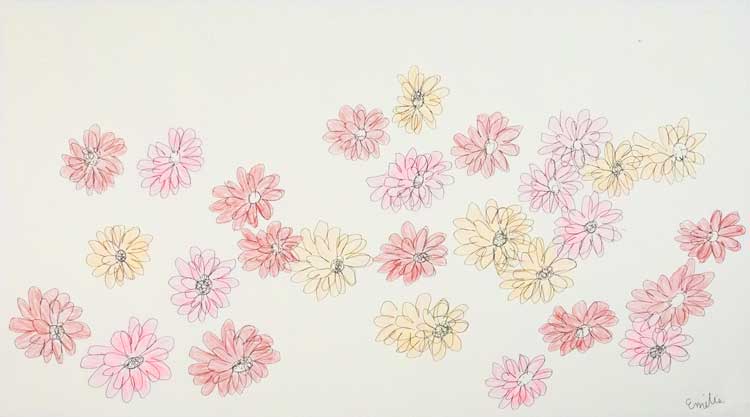
Emilie L. Gossiaux. Flowers for London, 2023. Ballpoint pen and crayon on paper 63.5 x 88.9 cm (23 x 35 in). Courtesy the artist.
A final observation relies on a feeling I had in the galleries that Gossiaux’s work is guided by something like a philosophy of openness whose opposite would be critical inscrutability. Yes, we can find formal instantiations of openness in the work: the non-closure of line in the pen renderings of London (Dancing, Again, 2023) and blossoms (Flowers for London, 2023), for example, as well as the use of the gallery wall as negative space to cohere Gossiaux’s individual leaves into whole trees. But what I mean, rather, is that in its recommendation of alternative structures for living, Gossiaux’s work functions like a container for reimagining worlds that accommodate whatever structural and ideological alterations our embodied experiences of difference demand. This is especially the case since disability identity is one that we all move in and out of over the arc of our lives, which is not the case with race or (to a lesser extent) gender. In an ecofeminist gesture, Gossiaux’s mode of storytelling opens itself to her viewers, shedding artistic postures of authority over us, and over nature. Perhaps this is why she enshrouds us in trees.
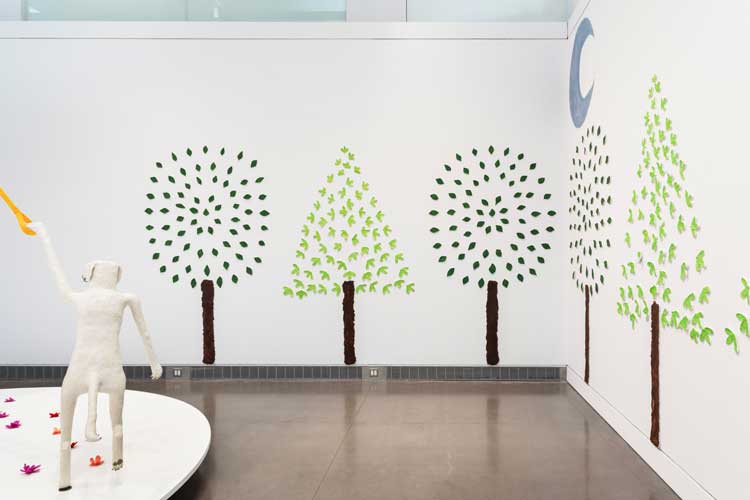
Emilie L. Gossiaux: Other-Worlding, installation view, Queens Museum, New York, 6 December 2023 – 7 April 2024. Photo: Hai Zhang, courtesy Queens Museum.